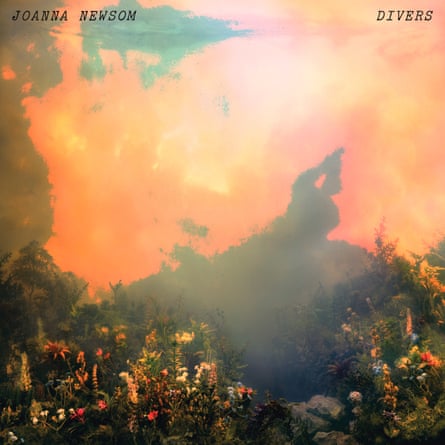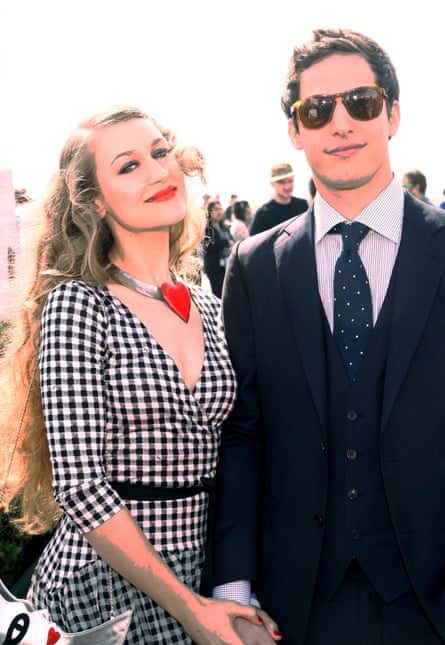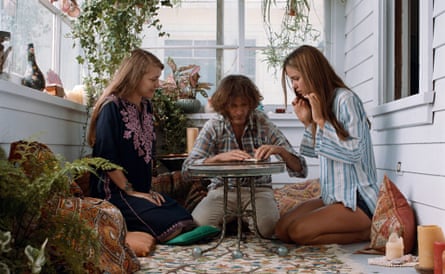In early August, out of nowhere really, Joanna Newsom announced that she was releasing a new album called Divers on 23 October. It would be her first record for five years – “half a decade” as some blogs would sensationally report it – and as a taster she presented a video for the song Sapokanikan, shot by Paul Thomas Anderson, the director of Magnolia and The Master. This was a big concession from Newsom, who is usually guarded about releases before they come out, and it allowed the army of her most dedicated admirers – “the delvers” as she calls them today – a head start in trying to figure out what the 33-year-old US musician had been up to in the long hiatus and what twisted, unexpected rabbit holes Divers might take them down.
Newsom is almost always described as “singular” and with good reason. She is a singer whose ethereal, warbling voice instantly confuses and sometimes angers those who hear it; her primary instrument is an orchestral harp. She writes songs that last 17 minutes and avant-garde albums that swoop and soar over multiple discs. And yet each of her records – Divers is her fourth – has sold many hundreds of thousands of copies. She is, no question, a superstar of independent rock music; one who can take five years on new work sure in the knowledge that her return will be an event. She is also, perhaps, an artist whose success refutes the idea that attention spans have dwindled and that complexity is a turn-off.
Newsom has almost a Moriarty-Holmes relationship with her most ardent fans: that of the old-time master criminal and the intellectual detective who understands him better than anyone. Or perhaps it’s more aptly compared to the link that joins the crossword setter and puzzle enthusiasts. Over the course of her career, Newsom’s lyrics have become ever more intricate and she accepts that a degree of obfuscation is almost expected from her now. Sapokanikan, for example, was the result of more than two months reading around on subjects from American history to the Romantics, then a couple of weeks working on the final lyrics.
“It’s very reassuring in a way to know that the elements I spent a long time embroidering into – or, in some cases, burying in – the lines will pretty much always get found by someone,” says Newsom when we meet in a shabby photographic studio in east London. “It’s a nice relationship, I would say. I don’t know how to put it without sounding corny, but I do feel there’s some sort of exchange that happens there.”
Newsom is in the UK for a couple of days when we meet, a brief stop before even more fleeting sojourns in Paris and Berlin, then back to the States. She’s clearly boggled with jetlag – she doesn’t sleep too well at the best of times – but she’s engaging and effervescent, with startling, mostly green eyes that appear to shimmer like the northern lights. Demure, with the impeccable posture of a lifelong harpist, she is dressed primly, like a fashion-conscious librarian, apart from the ring finger of her left hand on which is a rock that ships should steer clear of. She’s very serious about her work but not especially about herself, which is probably as it should be.

Sapokanikan – a jaunty, radio-friendly earworm that fuses waltz, ragtime and other musical styles – has proved to be especially rich and satisfying for the delvers, like stumbling across Sutton Hoo. The title of the song comes from the name of a Native American village that was situated in lower Manhattan, roughly where Greenwich Village is now, before the Dutch arrived. In simple terms, Newsom explains reluctantly, the lyrics are about “the history of a piece of land, the things that happen on the same basic plot of earth”, but her exploration of this idea led her to incorporate references to Shelley’s sonnet Ozymandias, the work of the Australian artist Arthur Streeton and a history of overpainting, and John Purroy Mitchel, the “Boy Mayor” of New York City from 1914-17.
I make the mistake of referring to the preparation that went into writing Sapokanikan as “research”. “I don’t know I’d describe what I’m doing leading up to that song as ‘research’,” she says. “For me, it’s more having a hunch and following through on the hunch. Having an almost religious faith in the fact that certain things are connected and I have to lasso them all into the same place. Research: that word feels so cold to me in a way. Because it’s all very compulsive and very emotion-driven.”
Within a day or two of Sapokanikan being released, the delvers had already posted detailed annotations of the song online. Newsom gives top marks to a music website called genius.com, which crowdsources the opinions of fans to unpick tracks. Bottom of the class is the NME blog, which brilliantly misheard one particular line: so, “Depart for the western front, where work might count” became “Depart for the western front, where I walk my cow”.
“‘Where I walk my cow’, yeah,” muses Newsom. “Well, that’s nice. That’s not right, but…” She laughs. “So off. So far off. But so confident! Me and my trusty cow.”
But there is one response to Sapokanikan which, when I read it back to Newsom, gives her more pleasure than any of the others. The most popular comment on YouTube that morning is: “I didn’t understand a word, but I fucking loved it.”
“Yeah!” she exclaims. “I’m overjoyed to hear that. It’s wonderful. They are songs, so the priority for me is that the melody is good and the instrumentation is exciting and interesting and new and that it resonates with people on that level. If they said they love it, then they are getting what they show up for. They show up for something and, whatever they show up for, they got that thing. I would never presume to think they need more from that song.
“There are lots of songs I don’t understand,” she continues. “Like I don’t frankly know what ‘I am the walrus’ means as an expression, but I’m not mad at the Beatles for not explaining. Think of it as nonsense if you like; I’m fine with that.”
Joanna Newsom’s music has always made a forthright appeal to both hearts and minds. Born in 1982 in northern California, she grew up in a forty-niner gold-mining town called Nevada City. The story is that at the age of four she asked her parents – both doctors and adept musicians, especially her mother who played piano, hammered dulcimer and autoharp – if she could learn the harp. The local teacher wouldn’t take on a student so young and suggested she take piano lessons instead. Newsom became a virtuoso on both instruments. Up to the age of 10 or 11, she went to Steiner Waldorf schools and it was here that she had to memorise translations of long, involved German poems about saints and wild animals – a handily transferable skill when you write songs as lyrically complex as Newsom’s.
Her debut album, The Milk-Eyed Mender, released in 2004, was mostly vocals and harp. Its follow-up in 2007, Ys – pronounced “ees”, named after a mythical city on the coast of Brittany that was swallowed by the sea – was more ambitious in form: just five tracks that each run between seven and 17 minutes. Ambitious in sound, too: her hypnotic, spooky soprano was backed up at times on the album by a symphony orchestra. Both records were critical and commercial successes – selling, respectively, 200,000 and 250,000 copies – though not universally admired. A comparison between Newsom’s voice and Lisa Simpson’s turned up more than once.
Such criticism didn’t really sting Newsom, but there were recurring themes in the articles that did. “A lot of the writing about my music is done through a lens of straight-up sexism and, in other cases, just a coding of feminising of things,” she says. “I’ve ranted about this in the past, so I don’t want to go into it too much again. But there’s a quality I might share with…” She goes silent for a few moments. “I’m trying to think of a male musician I’ve ever been compared to. Like early, early days: Devendra Banhart. He and I had some aesthetic similarities: the music was pulling in some ways to a similar place. But where for him people would use words like ‘eccentric’ or ‘psychedelic’ and for me they’d use ‘fairytales’ and ‘unicorns’.
“It’s an infantilising thing that happens,” she goes on. “The language is minimising and narrowing of possible narrative depth. It’s the opposite of delving, really. But this is ancient history. I’ve not paid as much attention as I used to, because it was so disturbing to me when I was younger.”
You do not have to read much about her to see that Newsom has a point: “naive”, “elfin” and “childlike” are recurring adjectives, especially in early estimations of her work. The snipes seem to tail off a little around the release of her third album, Have One on Me, in 2010, in part perhaps because it is a tough record to be flippant about: three discs, 18 songs, more than two hours of smart and wondrously fused pop, country, gospel and classical. The title track was inspired by Lola Montez, an itinerant Irish-born burlesque dancer in the 19th century who became mistress to the king of Bavaria and used her power to advance a liberal agenda. Newsom became interested in Montez because she had lived for two years in Grass Valley, where Newsom was born; mostly, though, she found herself identifying with her as a woman and a performer.
A couple of years ago, a friend of Newsom’s sent her a link to a feminist blog that had detailed discussions of her music and the commentary on it. “It was kind of a tonic to read it and know I’m not an insane person,” says Newsom. “It was rounding up examples and pointing out the sexist shit people continuously write. So, there was a little bit of ‘Thank you!’ But everyone has their own thing they have to deal with, that gets said about them in reviews, it’s fine. There’s great writing out there and writing that would ruin my day if I read it, I’m sure.”

These days Newsom just tries to avoid reading the coverage of her work and personal affairs. (The attention has been amplified dramatically since she began a relationship with Andy Samberg, a comedian, actor and one-third of the comic pop group the Lonely Island. They married in 2013.) “It can lead to a little bit of that existential panic that you get from staring at a mirror too long,” she says. “You end up feeling awful about yourself. Or weird. Bare minimum: like you’re on a weird drug. Worse-case scenario: like you’ve done terrible things with your life.”
Early on with the album that would become Divers, Newsom became aware that it would not be a straightforward assignment. “More than anything I’ve done in the past, I had a sense that it would take me a long time to make this record,” she says. “It was really just a case of hunkering down and being like” – she rubs her palms together – “‘Right, let’s do this four-year project!’” She says that although she feels more experienced, more confident certainly now, that didn’t make the process any easier. “No, this record seemed to be the hardest one. But it was the most fun as well.”
On cursory examination, Divers could be mistaken for a more conventional record than her previous releases: 11 tracks; a compact 52 minutes. But the complexity – the four years – becomes evident the more you listen. The lyrics often return to love lost and found, viewed from different historical perspectives. There’s an autobiographical slant – New York, where she lived with Samberg while he was still a cast member on Saturday Night Live, is referenced often; the couple now live in Los Angeles, reportedly in a house once rented by Charlie Chaplin – but the allusions are invariably oblique. Arrangements are supplied by, among others, the influential composer Nico Muhly and multi-instrumentalist David Longstreth of experimental indie band Dirty Projectors.
It is, however, Newsom’s own skills and idiosyncrasies that really impress on Divers. Sometimes these are showcased with classical rigour through voice and harp or piano; elsewhere they are given more exuberant expression, such as on Goose Eggs where she plays Wurlitzer and Baldwin Discoverer organs, a five-octave clavichord, electric harpsichord and Rhodes piano. “We recorded the album in this one dude’s private studio that he sometimes lets people record in,” says Newsom, referring to Vox Recording Studios in Hollywood. “He has this incredible collection of instruments and there were a lot of days where we would root around and stack some piles of keyboards. I’d describe a sound I was looking for and this really sweet engineer, Michael, would pull something out and say, ‘Try this!’”
The final mix, which on previous albums had taken two weeks, sprawled to six months on Divers. And Newsom was more involved in this stage than she had ever been before. “It was just this immersive, deliriously inspired experience,” she recalls. “I’m trying to think of a word that isn’t too idealistic, but it was very joyful. There was a real abandon. A complete emerging… Or immersing myself in it.” Newsom, who is usually very precise with her use of words, goes silent for a few seconds and then reboots: “Jetlag break! I was just completely occupied with the record in a different and new way.”
It sounds intense. Newsom even avoided listening to all other music in case it influenced hers. “It just happens, your brain absorbs shit without realising,” she says, “which has been hard for my husband because he’s a huge fan and loves music playing all the time. So it’s a negotiation.”
Newsom’s most prolonged distraction from making Divers came when she received a text from Paul Thomas Anderson, who is a friend, asking her to record herself reading sections from Thomas Pynchon’s Inherent Vice. Anderson was adapting the hallucinatory detective novel for the screen and he figured that Newsom’s lilting cadences might be right for a narrator for his film, which was released last year. She wound up appearing on camera, too, as Sortilège, the confidante to the perpetually befuddled Larry “Doc” Sportello, played by Joaquin Phoenix. Not bad for an acting debut.
“There was a point where Joaquin asked me if I had ever acted in anything before,” says Newsom, “and I said, ‘Not really. Certainly not on camera. I don’t know what I’m doing. I’m so nervous.’ And he was like, ‘Oh, do you think any of us know what we’re doing? Right before I start a scene’ – I don’t want to misquote him here, but he said something along the lines of, ‘I always feel that I’ve never done this before.’”
Newsom – an avid Pynchon fan – clearly warmed to the experience of acting, but she isn’t giving up the day job just yet. “Since Inherent Vice, I’ve mostly been asked to audition or read for things and I have not done that, because it’s not a world that I really want to get into,” she says. “It just seems so… I’m too old for this shit. This is not a moment in my life where I want to start hustling. Seeing if they think I’m the right person for this HBO thing or whatever. It’s just a thing that, if it happens naturally, if it’s like the situation with Paul where he was like ‘I think Newsom’s the man for the job,’ then I’ll show up and do it.”

Should Newsom ever stop making music, she figures that she might make a more dramatic shift. “I’ve realised, there’s like a 40% chance that when I’m an older woman, I’ll become the weird, eccentric interior decorator. Look out for that! That’s my next chapter.”
Newsom is messing around, although maybe not. She talks with such knowledge and compulsion about Jean Royère tables, Swedish art deco, and the Vienna Secession movement that it’s difficult to tell. “I’ve developed a borderline unhealthy obsession with design and specifically furniture design,” she admits. “I will go very deep into the world of looking at furniture. It doesn’t serve much purpose other than the way someone would watch a lot of football. I’m a fan! I’m a furniture fan!”
Does she buy the pieces she spots? “I do not,” she replies, ruefully. “I can’t buy a Jean Royère table, it costs $100,000. Literally, not an exaggeration.” She does, however, relate with unrestrained glee finding a vintage Süe et Mare rug at auction. She identified it in a book she has, Art Deco and Modernist Carpets, verified the distinctive monogram in the corner, and bought it for around $200. Later she discovered that the same rug is in the permanent collection of the Metropolitan Museum of Art. “I was losing my shit, because I was so sure that someone else would figure it out before me and buy it for what it was worth,” she says. “But no one did. That’s the last frontier of finding a deal: real auctions, not eBay, but actual auctions where you participate in real time.”
Furniture design and watching television – “You’ll be shocked but I’m very into Game of Thrones! That’s the scoop of the century” – serve, Newsom thinks, to create a buffer from the ornate, high-minded and consuming world of her music. “Oh, there’s definitely an hour of the day where I pour a goblet of pinot noir and watch Downton Abbey or whatever,” she says. “I compartmentalise a little bit. When I’m working, I’m not fun to be around; it’s just a specific part of my brain and then I live in other parts of my brain at the other times of the day.”
We have spent too long discussing the allure of French and Italian mid-century furniture and how True Detective lost its way. Newsom needs to get going – she has to be in Paris tonight. No wonder, I say, it takes her five years to make a record. “I know,” she laughs. “I’m going to make a bunch of people mad. They’ll be like, ‘Stop watching TV! Get off the internet!’”
Fortunately, with Divers, Newsom has given the “delvers” – and the people who just simply “fucking love” her music – plenty to be getting on with.

Comments (…)
Sign in or create your Guardian account to join the discussion